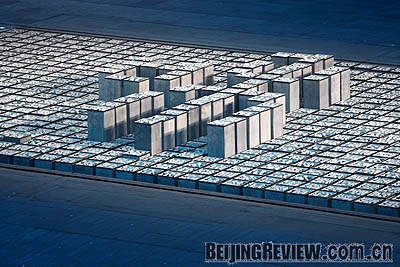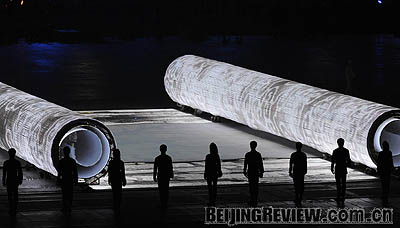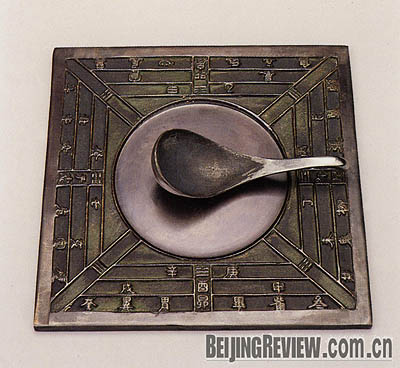|

TYPE CAST: Performers created the Chinese character for harmony through an innovative hidden dance sequence, to convey China's wishes for peace and harmony
A giant scroll painting rolled open at the center of the National Stadium, or Bird's Nest, during the Olympics opening ceremony on August 8, serving as the glittering stage for displaying China's 5,000-year-old civilization.
For almost three hours the color, dazzle and elements of Chinese magic captured the world's attention.
"It [unrolling scroll] will be the most classical snapshot of this opening ceremony in my memory," Zhang Yimou, the director of the design team of the breathtaking show, told Life Week on August 10. Zhang and his team creatively wove China's four great inventions-papermaking, moveable-type printing, compass and gunpowder, into the scroll to show off the highlights of Chinese civilization.
Collective painting
The scroll itself represented the ancient invention of papermaking, one of China's contributions to the spread and development of human civilization.
Cai Lun, an eunuch during the Eastern Han Dynasty (25-220), is widely regarded as the person who improved the papermaking technique and reduced the cost of producing large volumes of fine paper. Recent archaeological discoveries date the actual invention of papermaking some 300 years earlier than Cai in the first century.
The scroll functioned as a thread throughout the opening ceremony and formed the backdrop to the unique performances. In the center of the scroll lay a sheet of blank "paper" on which dancers dressed in black moved their bodies to resemble the ink strokes from a brush. The movements created patterns that eventually formed a landscape painting, children painted the mountains green and water blue, and finally the athletes themselves trod a rainbow of color on the painting during the team parade.

ON A ROLL: A giant scroll painting, symbol of China's invention of paper, provided the setting for a historical stroll through China'a 5,000-year civilization (PAUL KITAGAKI JR.)
"China unfurled a beautiful painting to the world, which depicted not only the traditional culture of China and the evolution of the country's history, but also the future of humankind," said Yves Pepin, head of the French entertainment group ECA2 in Life Week. "The painters were from all over the world and everyone left their mark on it-a memory you can wrap up and take home."
Lasting impression
Among the most stunning moments of performances was the demonstration of printing. A total of 897 performers hidden in gray blocks engraved with
Chinese characters rose and fell in unison, resembling movable types. Ripples of movement created the character "he" for "peace and harmony" three times in different styles, followed by an image of the Great Wall.
Without warning, the "blocks" sprouted peach blossoms-a symbol of spring, the season of hope, prosperity and wealth in China, and performers from their cocoons waved to the crowd.
Jane Macartney, a correspondent with The Times in Beijing, interpreted the message in her story Olympics: the power and the glory-China leaves world awestruck as "the shock and awe of China's Olympics-the most expensive in history at $43 billion-do not portend the arrival of a country that could menace the world."
Printing in China dates back to the Song Dynasty (960-1276) when Bi Sheng invented movable-type printing in 1040, more than 400 years earlier than it appeared in Europe. Bi accomplished a significant revolution in the history of printing, because all later printing methods such as wooden type, copper type and lead type printing were developed on the basis of his movable clay types.
Navigating history
During the "Silk Road" performance, a dancer emerged holding an ancient compass in his hand. Dancers surrounding him wielded huge painted paddles to recreate the maritime expeditions of the 15th-century Chinese mariner, Zheng He.
The Silk Road was an important passage for economic and cultural exchanges between China and Western countries during the Tang Dynasty (618-907).
Zheng He's expeditions navigated the "Silk Road" on the sea, during the reign of Emperor Yongle in the Ming Dynasty (1368-1644).
Emperor Yongle believed in an open-door policy in international diplomacy and trade. He sent Zheng on overseas voyages to make China's strength known to the world and to spread Chinese culture. Zheng's team used the compass and position of the stars to navigate their way across the world, from the South Pacific, Indian Ocean and Persian Gulf to Africa in seven epic voyages from 1405 to 1433, 80 years earlier than Columbus' accomplishments.

GIVING DIRECTIONS: The early form of the compass, Si Nan featured a magnetized ladle
The compass was based on a device called Si Nan during the Warring States period (453B.C.-221B.C.). Si Nan was a ladle-like magnet on a plate with the handles of the ladle pointing to the south. The early form of the compass was a magnetized needle floating in a bowl of water, or "wet compass," invented in ancient China sometime before 1044.
Explosive delights
Gunpowder was represented in the ceremony by the spectacular fireworks displays. Following the countdown, 29 massive firework footprints lit up the night sky, marching all the way from Tian'anmen Square to the National Stadium, along the city's north-south axis, symbolizing 29 Olympic Games.
The invention of gunpowder was credited to Chinese alchemists in the ninth century searching for an elixir of immortality. It is the mixture of potassium nitrate, sulfur and charcoal-elements that people took as medicine in ancient times, hence the name "huo yao" in Chinese means "burning medicines." Gunpowder was used in wars in the early 10th century, and the earliest surviving recipes for explosives can be found in the Chinese military treatise Wujing Zongyao of 1044. |